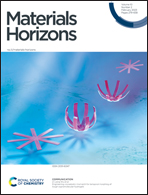Inorganic frameworks of low-dimensional perovskites dictate the performance and stability of mixed-dimensional perovskite solar cells†
Abstract
Mixed-dimensional perovskites containing mixtures of organic cations hold great promise to deliver highly stable and efficient solar cells. However, although a plethora of relatively bulky organic cations have been reported for such purposes, a fundamental understanding of the materials' structure, composition, and phase, along with their correlated effects on the corresponding optoelectronic properties and degradation mechanism remains elusive. Herein, we systematically engineer the structures of bulky organic cations to template low-dimensional perovskites with contrasting inorganic framework dimensionality, connectivity, and coordination deformation. By combining X-ray single-crystal structural analysis with depth-profiling XPS, solid-state NMR, and femtosecond transient absorption, it is revealed that not all low-dimensional species work equally well as dopants. Instead, it was found that inorganic architectures with lesser structural distortion tend to yield less disordered energetic and defect landscapes in the resulting mixed-dimensional perovskites, augmented in materials with a longer photoluminescence (PL) lifetime, higher PL quantum yield (up to 11%), improved solar cell performance and enhanced thermal stability (T80 up to 1000 h, unencapsulated). Our study highlights the importance of designing templating organic cations that yield low-dimensional materials with much less structural distortion profiles to be used as additives in stable and efficient perovskite solar cells.



 Please wait while we load your content...
Please wait while we load your content...